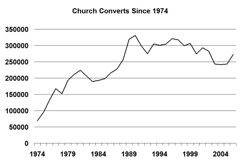I decided to go through the reports of the April general conferences since 1974 and track the number of converts reported each year. I noticed some interesting things.
First of all, there was a huge amount of growth from 1974-1990. The bulk of this time was under President Kimball’s administration and five years of it was under President Benson’s.
Second, there appear to be small pockets of growth decline every few years.
Third, from 1978 to 1982, the reported number of converts was rounded to the thousands place (152,000, 193,000, etc).
Finally, and perhaps most notably, the number of converts has been on a general decline since 1990, when it had reached a record 330,877 converts. In fact, last year, the number of converts reported was at the lowest it has been in 16 years.
UPDATE (02 April 2006): Added 2005 stats. Annual growth for 2003?¢‚Ǩ‚Äú2005 has been stable at roughly 240,000. I could not find stability trends in other years.
UPDATE (31 March 2007): Added 2006 stats. Convert growth is back on the rise.

Oddly enough the current down-trend is during the same period that Internet use has climbed.
Do you think that the Internet has had an adverse effect on the number of converts per year?
I think it has to do with the church being concerned about the retention rates. Even though the church reached an all time high in 1990 with growth, I think they probably reached another record in low retention.
I have a feeling a lot of the people who joined the church initially met with the misisonaries to learn more and then ended up accepting their commitments. Now they can get information about the church without meeting with the missionaries and without risking pressure sales tactics.
I’m not really seeing the internet affecting this much. Otherwise the 3rd World countries’ conversion rates would be static, but they are falling as well.
I believe there is also been a big drop in the number of missionaries due to the end of the baby-boomers, raising-the-bar, etc.
That is an interesting trend indeed, and one I hadn’t heard about. I wonder what the analysts (if any) are saying.
Perhaps there has been more of a focus on retention.
It sounds feasable that the internet is affecting things. There are probably many factors to think about.
I wonder if this gradual decline because fewer new countries have been allowing missionaries in. I don’t have any data to back that up or anything.
It seems we would also need to look at a chart in total Church membership over the same period, to get a real feel for what the Church’s growth has been.
(…that’s a chart “of” total Church membership…)
I find that interesting as well. I would LOVE to see a chart that shows actual membership of “attending members” not including those who are inactive etc. I would find that very interesting. But, I do feel strongly that we are going to see more and more of a decline and more people leaving the church as we get closer to the second coming. I think it will become increasingly harder to convert people to the gospel, but that is just my own opinion.
K.
Kris, you may want to check out:
http://www.cumorah.com
Lots of stats there.
When did the 3 hour block start? Think about it. Also, the 3 hour block is good for managing but horrible for making friends. Just like the 18 month missions did not work, perhaps the 3 hour block is not the best either.
Yeah, but at least we don’t have to go to church in the morning and then come back again LATER. There isn’t much wrong with the 3 hour block. And you can make friends outside of church time (like hey HOMETEACHING!)
Rick: Interesting site you referred to, although I find some of their graphic represenations utterly unhelpful. Didn’t find what I was actually looking for, though, which is just a simple tracking of total Church population. I’m sure it can be found if one tries hard enough. Alternatively, I can just read the statistical report from each annual general conference and make my own graph.
I added 2005 stats. Annual growth for 2003-2005 has been stable at roughly 240,000. I could not find stability trends in other years.